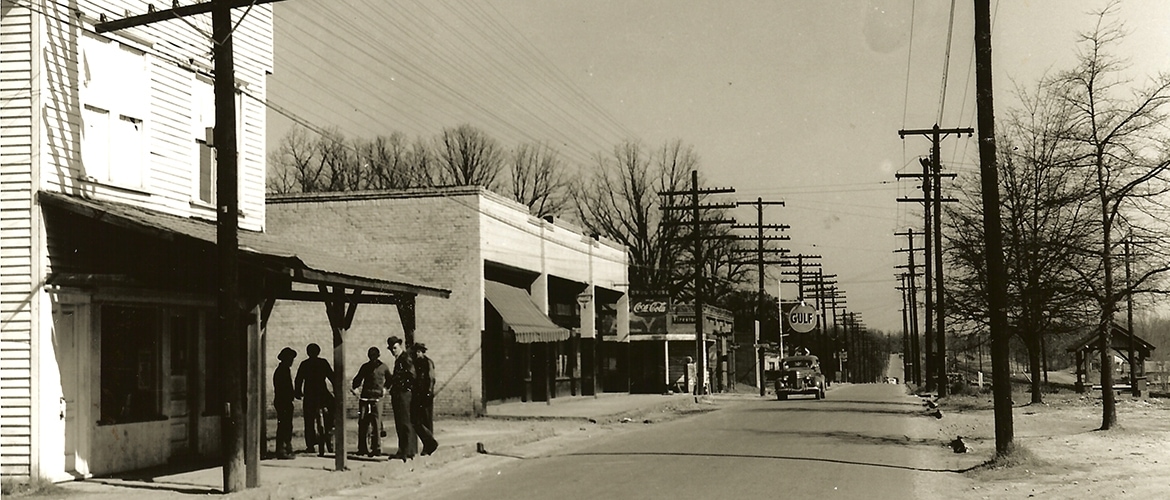
Clarkston in the 1940s, Courtesy of DeKalb History Center
Throughout its history, the small city of Clarkston, Georgia, has remained just that: a small city. In the face of a rapidly changing and expanding metro Atlanta region, the construction of major interstate highways, and other dynamic regional changes, Clarkston has remained an incorporated city of under two square miles. While the population has certainly grown since its humble beginnings as a stop on the Georgia Railroad back in the late 1800s, it has nevertheless kept its small town feel.
What has changed—dramatically—is the makeup of Clarkston’s population. Of the people who call Clarkston home today, roughly 50% of people were born outside of the United States.
How does a small city like Clarkston become such a diverse hub of immigrants, especially located in the heart of the Deep South and next to a major metropolitan center? As it turns out, a combination of national factors and local characteristics that date back to Clarkston’s origins have contributed.
The original Clarkston school building constructed in the 1880s, which later became City Hall for a few years. Courtesy of DeKalb History Center.
Clarkston was officially incorporated on December 12, 1882, but a post office had existed since 1876 and a settlement before that—all on the Georgia Railroad. Newspaper ads around the turn of the 20th century advertised pristine vistas and generous allotments of farmland. Population growth was slow-going in the early years. In a report to the DeKalb County Historical Society, Jabes C. Estes recalls that when the militia district of Clarkston was created in 1880, there were only around 65 homeowners and few tenants in the area. By 1914, Clarkston had become accessible not only by railroad, but also by street car and highway from Atlanta.
Throughout the first half of the 20th century, Clarkston stayed a small town, with the majority of the population being Georgia natives, but the population would begin to shift starting in the 1970s as immigrant populations arrived.
Immigrants arrive at Ellis Island in the late 1910s. Photo captured by Bain News Service; Library of Congress, Prints & Photographs Division, LC-DIG-ggbain-30547
A Brief Overview of U.S. Immigration and Refugee Policy
The international and national systems that set up Clarkston to become the immigration and refugee resettlement hub that we know today have their roots in the post-World War II era.
Prior to World War II, there was no distinction in United States immigration policy between a refugee and an immigrant. Instead, laws placed particular focus on nationality and race as qualifications for entry into the country. For example, the Immigration Act of 1875 and the Chinese Exclusion Act (repealed in 1943) were the first restrictive immigration laws. In 1921, the first immigration law that stipulated widespread quotas based on nationality was passed, capping annual immigration at 3% of the foreign-born population of that nationality in the 1910 census.
The United States remained isolationist up until World War II, which was reflected in its immigration policy. Even after the war began, the quota system was kept in place. Following the devastation, genocide, and huge number of displaced people resulting from the war, the newly-formed United Nations decided that a formal distinction needed to be made between immigrants and people fleeing due to persecution—refugees. The United States also adopted new policies, although these were refined over several decades. Early post-war policies mainly focused on admitting refugees from communist countries and allowing numbers to be set on ad hoc basis, while the whole nationality quota system was replaced with a tiered preference system in 1965. The 1980 Refugee Act signed into law by President Jimmy Carter, formally codified the term “refugee” to match the UN’s definition, established a higher ceiling for admissions, and generally created the system for refugee resettlement that is still in use today.
Uhuru Dancers perform at the Embrace the Future Gala benefitting the Clarkston Community Center in July 2017. Courtesy Clarkston Community Center
Clarkston as a Reflection of the World
In the 1970s, near the end of the Vietnam War, the number of Vietnamese refugees wanting to come to the United States increased, therefore increasing the impetus for the 1980 Refugee Act. Georgia and, specifically, Clarkston, received some of these refugees. In 1975, The Atlanta Constitution reported on an American family repairing an old house in Clarkston for a Vietnamese family fleeing after the fall of Saigon. Several years later, newspaper coverage focused on refugees from Bosnia and other conflicts. These stories mark the start of a trend in news coverage regarding Clarkston—it became a reflection of the people who were relocating to Clarkston, themselves reflective of areas of global conflict. Since 1980, over 60,000 refugees have relocated to the city and its surrounding area.
Much of the reason that Clarkston became a hub for refugees ties directly to its founding and development as a convenient suburb of Atlanta. While Clarkston was a popular suburb, particularly after the completion of I-285 in 1969, its population declined as residents moved to suburbs further out from the city. The relatively low cost of living, available housing, and public transportation to accessible jobs made and continues to make Clarkston an ideal location for people trying to get their footing in a new country.
Prior to entering the United States, refugees have to first qualify for resettlement and then undergo a long, thorough process that includes detailed security and medical checks. Upon entering the United States, refugees are assisted in resettlement by non-governmental refugee resettlement agencies, which help with determining placement and arranging housing and travel. A myriad of local refugee services organizations in Clarkston help refugees in finding employment, education, family resources, and building civic engagement. Funding for travel arrangements to the United States is a loan that must be repaid, but the U.S. State Department provides three months of assistance, while the U.S. Department of Health and Human Services offers programs that provide a few more months of support. Further programs provided by local refugee organizations strive to help refugees attain self-sufficiency starting at six months.
Refugee resettlement and immigration to Clarkston began to grow in the 1980s, but it increased significantly during the 1990s. According to The Atlanta Constitution, Clarkston’s foreign-born population was 9% in 1990, but had jumped to at least 18% by 1995. The terrorist attacks on September 11, 2001, put a nationwide stop and then slowdown of immigration, particularly refugee admissions, but today Clarkston has once again taken its place as a refugee resettlement hub.
Making History Today
Clarkston has garnered national and international attention over the past decade, and the town is constantly changing and adapting as new residents arrive and others depart. This flux has come with challenges, and the city has had its share of growing pains as it determines the best way to meet the needs of all of Clarkston’s citizens, ranging from those who have just arrived to those whose families have lived there for generations.
Some of the city’s staple institutions, such as the Clarkston International Baptist Church, have experienced this challenge deeply and personally. Founded in 1883 as the Clarkston Baptist Church, the church added “international” to its name in 2004 to recognize merging with the Filipino International Bible Church in its first step to create an international coalition. In another example, a conflict over the practice site of a refugee soccer team known as the Fugees launched Clarkston into national news as city officials, city residents, and the soccer team of refugee boys sought to resolve tensions, which eventually resulted in the City Council’s affirmation of the Fugee’s right to use the city’s multi-use practice field. Years later, the Fugees have expanded to become Fugees Family, a non-profit organization that includes The Fugee Academy, the only school in the country dedicated to refugee education, in addition to after-school programs, summer camps, and family services.
One of the city’s oldest institutions—city government—has also changed and adapted. In 2014, the City of Clarkston joined Welcoming America’s Welcoming Cities and Counties Initiative and also adopted a Compassionate City resolution, affirming the city’s commitment to being a welcoming community for people of all backgrounds.
The history of Clarkston coexists beside the current city. The old Clarkston High School, opened in the early 1900s, is now the Clarkston Community Center that serves many different groups and provides enriching programming to create a stronger community. And, as the city of Clarkston notes on their city’s history page, the railroad still runs through the center of town as a reminder of the humble beginnings of one of Georgia’s truly international cities.
Join us in exploring more about the history of Clarkston at our August Party with the Past event at the Clarkston Community Center! We’ll have tours of the building and international vendors will be selling handmade goods. Food will be available for purchase from local vendors, and of course, beer, wine, and soft drinks will be for sale throughout the evening. More information here!
A special thank-you to the DeKalb History Center for helping to supply images and research resources for this blog post.


